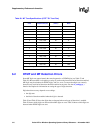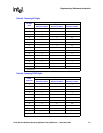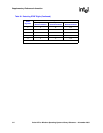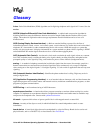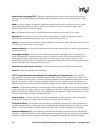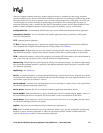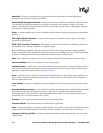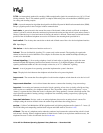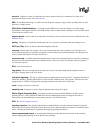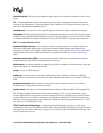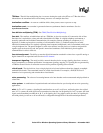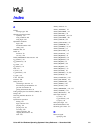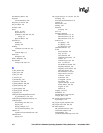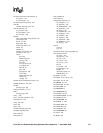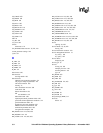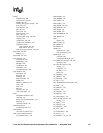
548 Voice API for Windows Operating Systems Library Reference — November 2003
on-hook: Condition or state of a telephone line when a handset on the line is returned to its cradle (or an
equivalent condition occurs). See also hook state.
PBX: Private Branch Exchange. A small version of the phone company’s larger central switching office. A local
premises or campus switch.
PCM (Pulse Code Modulation): A technique used in DSP voice boards for reducing voice data storage
requirements. Intel supports either mu-law PCM, which is used in North America and Japan, or A-law PCM, which
is used in the rest of the world.
physical device: A device that is an actual piece of hardware, such as a D/4x board; not an emulated device. See
emulated device.
polling: The process of repeatedly checking the status of a resource to determine when state changes occur.
PSTN (or STN): Public (or Private) Switched Telephony Network
resource: Functionality (for example, voice-store-and-forward) that can be assigned to a call. Resources are
shared when functionality is selectively assigned to a call and may be shared among multiple calls. Resources are
dedicated when functionality is fixed to the one call.
resource board: An Intel® expansion board that needs a network or switching interface to provide a technology
for processing telecommunications data in different forms, such as voice store-and-forward, speech recognition,
fax, and text-to-speech.
RFU: reserved for future use
ring detect: The act of sensing that an incoming call is present by determining that the telephone switch is
providing a ringing signal to the voice board.
robbed-bit signaling: The type of signaling protocol implemented in areas using the T-1 telephony standard. In
robbed-bit signaling, signaling information is carried in-band, within the 8-bit voice samples. These bits are later
stripped away, or “robbed,” to produce the signaling information for each of the 24 time slots.
route: Assign a resource to a time slot.
sampling rate: Frequency at which a digitizer quantizes the analog voice signal.
SCbus (Signal Computing Bus): A hardwired connection between Switch Handlers on SCbus-based
products. SCbus is a third generation TDM (Time Division Multiplexed) resource sharing bus that allows
information to be transmitted and received among resources over 1024 time slots.
SCR: See silence compressed record.
signaling insertion: The signaling information (on hook/off hook) associated with each channel is digitized,
inserted into the bit stream of each time slot by the device driver, and transmitted across the bus to another resource
device. The network interface device generates the outgoing signaling information.
silence compressed record: A recording that eliminates or limits the amount of silence in the recording
without dropping the beginning of words that activate recording.



